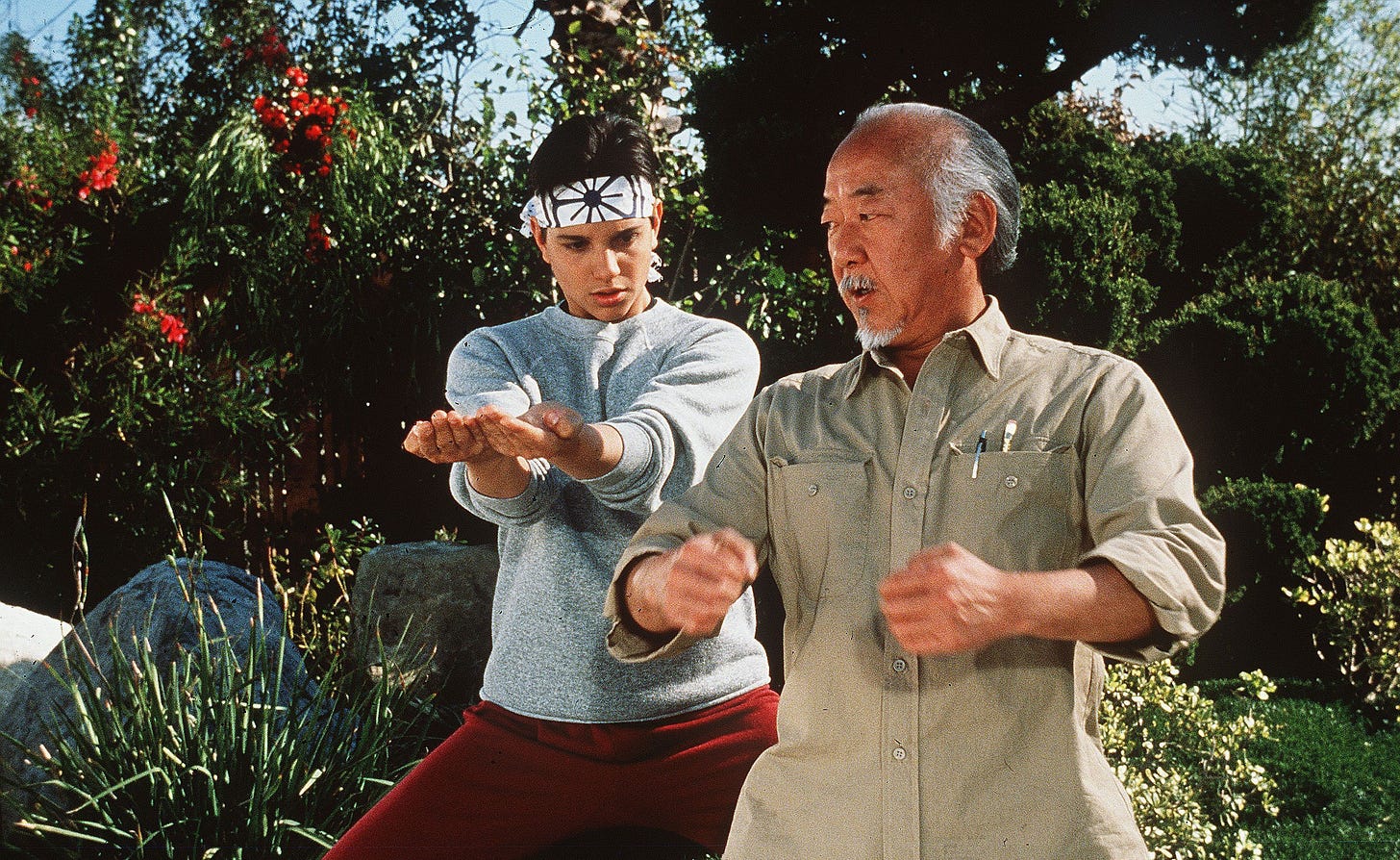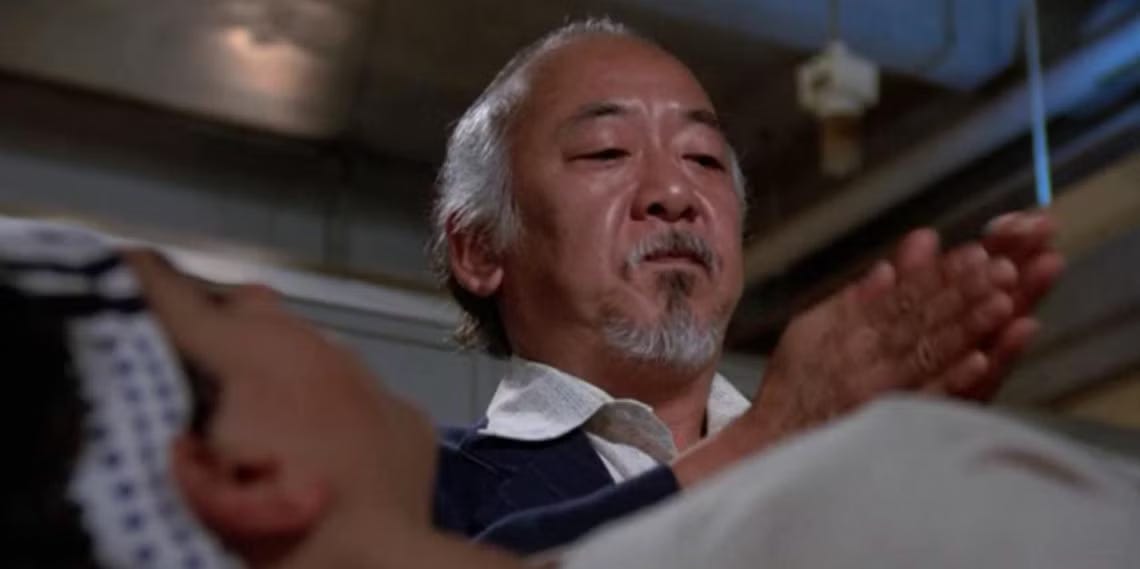What Masters Don't Teach Us
The Karate Kid, Miracles and the virtue of mystery
"An unanswered question is a fine traveling companion. It sharpens your eye for the road." - Rachel Remen
Great teachers share their knowledge freely and can intuit what a student(s) needs. Hopefully, you’ve had at least one good teacher or mentor in your life so far. But something I’ve noticed about the best teachers is that they leave some questions unanswered and do no more than make you wonder, “How did they do that?!”
In Star Wars, Obi-Wan uses a “Jedi mind trick” on Stormtroopers in Mos Eisley… “These aren’t the droids you’re looking for.” Luke is astonished, but Obi-Wan doesn’t explain how it works. He only offers that, "The Force can have a strong influence on the weak-minded." This is just hours before he offers his life up in a duel against Darth Vader, slightly winking at Luke before being struck down and vanishing into thin air. Mysterious power. Unexplained.
In The Lord of the Rings, Gandalf confronts the Balrog "monster” on the Bridge of Khazad-dûm and uses ancient, unknown power to stop it. “You shall not pass!” Many of his traveling companions must have been surprised at the degree of Gandalf’s power, and even more shocked by his apparent resurrection in The Two Towers. He keeps some of his cards close to his chest.
The other day, I finally (after 35 years) watched The Karate Kid (1984). I have no excuse. It just never struck me as essential viewing, but curiosity finally won out on a long flight back to D.C. from Los Angeles.
The Karate Kid deserves every ounce of praise I’ve ever heard.
Mr. Miyagi’s training of Daniel LaRusso in karate so that he can fend off neighborhood bullies and eventually win a martial arts competition is a masterclass in Hero’s Journey storytelling. It’s no surprise to me that this movie was released around the same time as Star Wars: The Empire Strikes Back, the first appearance of Master Yoda, one of cinema’s most iconic mentors.
Twice in the movie, LaRusso is hurt. Miyagi then stands over him, rubs his hands together quickly like he’s generating heat from friction, and lays his hand on the point of injury. In both cases, LaRusso is mostly healed.
NEW VIDEO FROM GEEKY STOICS
Neither the audience nor LaRusso gets an explanation, though one may emerge in the later Karate Kid sequels. I’ll find out as I watch them for the first time.
Modern moviegoers are insufferable as it relates to secret knowledge and backstory. At the first whiff of an unexplained backstory or ability, social media and reviewers huff and puff about the lack of realism.
I can imagine these types of people balking at Emperor Palpatine in 1983’s Return of the Jedi, demanding to know how fingers can shoot lightning.
Scientific thinking and materialism have not just dampened the reach of the church in America, but also the role of mysterious wonder in storytelling.
Certain adults who fancy luxury and alternative wellness solutions might recognize what Miyagi does as “Reiki” or something close to it. But for your kids watching The Karate Kid and everyday parents, what does it matter?
This man knows how to heal wounds and soothe pain. He is a MASTER. And even though healing would be of great use to his student, LaRusso, Miyagi never offers this information.
I’ve been reading C.S. Lewis’ “Miracles” over the past month, as part of Parker Settecase’s book club and guided essays on his Substack. There’s a part of this which reminds me of Lewis’ book on the plausibility of miracles.
A Miracle is defined in the book as an interference with Nature by supernatural power (Yoda lifting the X-Wing from the swamp)
A Naturalist is someone who believes nothing exists except Nature (Han Solo)
A Supernaturalist is someone who believes something else than just Nature exists out there (Yoda “Luminous beings are we, not this crude matter”)
Nature is basically something that occurs in our world without intervention and will always occur unless we take action to stop it (Death, Puberty, Injury)
Of course, Miyagi’s ability to heal his student can be explained by naturalists and someone with a mind for science or therapeutic practices. But the point of the healing method in The Karate Kid is to compel the audience toward magic/miracles/supernaturalism. Your imagination goes there.
A great teacher (Obi-Wan, Yoda, Miyagi, Uncle Iroh, Gandalf, Morpheus) sets the student down the path and makes them wonder.
As you mentor others and raise children, consider this in how you go about showing the details of different skills and arts. If you try too hard to explain the why of every little thing, it not only erases the student’s curiosity and awe with the practice, it also leaves less room for them to discover things for themselves.
Miyagi does this with the introduction of trimming Bonsai Trees as an art. The “how” of the practice is less important than the imaginative component, mindfulness, and simply doing.
I guess what I’m saying is: get more comfortable with unanswered questions
"Life is an unanswered question, but let's still believe in the dignity and importance of the question." - Tennessee Williams
Star Wars in the age of lost innocence
For all you fans of Star Wars: Andor, I have an essay out today in the Washington Examiner on the subject of Star Wars’ more adult content. The new show featured a sexual assault on screen, a first for Star Wars. It raises some valuable questions about innocence vs “realism” and what role parents play in guiding their kids through film/TV.




